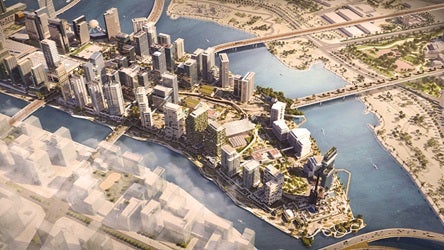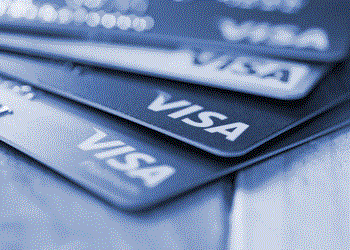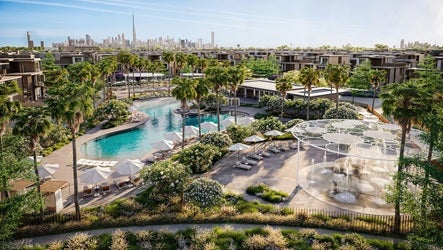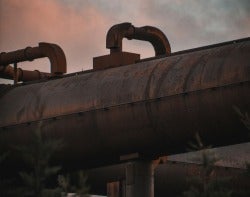Edgnex acquires Nordic data centre developer
2 April 2025
Register for MEED’s 14-day trial access
Edgnex, a subsidiary of Dubai-based property developer Damac, has acquired Helsinki-headquartered data centre-focused real estate developer Hyperco as part of its European expansion strategy.
Damac announced the acquisition on 31 March.
Hyperco operates data centres in Finland and Sweden, "leveraging the region’s renewable energy sources, mature digital ecosystem and high connectivity", local media reports said.
Hyperco's three co-founders and existing team will continue to lead operations through the next phase of growth, according to a statement by the company.
Hussain Sajwani, founder of Damac Group, said his firm plans to "build a significant future capacity in the Nordics and establish a strong foothold in the market".
Edgnex’s recent European activities include a €150m ($161.9m) joint venture in Greece with Public Power Corporation to develop a 12.5MW facility, expandable to 25MW, and a €400m commitment to build a 40MW data centre in Madrid, Spain.
In January, Sajwani pledged $20bn to develop data centres in the US.
Sajwani and then US President-Elect Donald Trump announced the plan on 7 January in Florida, a day after the US Congress certified Trump as the winner of the 2024 presidential election.
The project’s initial phase covers establishing data centres in Texas, Arizona, Oklahoma, Louisiana, Ohio, Illinois, Michigan and Indiana.
It was previously reported that the Dubai-based property developer plans to develop $1bn-worth of data centres in countries in Europe, Asia, Africa, the Middle East and the Commonwealth of Independent States.
Edgnex is constructing two data centre facilities in Dammam and Riyadh in Saudi Arabia that will deliver 55MW in 2025. There are also plans for a data centre in Amman, Jordan, and another in Turkiye in partnership with Vodafone.
In May, Damac announced its entry into the Indonesian market with plans to build a 15MW data centre in Jakarta. The first construction phase for the facility is scheduled to be completed in the fourth quarter of 2025.
Exclusive from Meed
-
 Regional rail industry emerges
Regional rail industry emerges8 December 2025
-
 Aldar and Mubadala plan $16bn financial district expansion
Aldar and Mubadala plan $16bn financial district expansion8 December 2025
-
 Visa agrees to support digital payments in Syria
Visa agrees to support digital payments in Syria5 December 2025
-
 Meraas announces next phase of Nad Al-Sheba Gardens
Meraas announces next phase of Nad Al-Sheba Gardens5 December 2025
-
 Frontrunner emerges for Riyadh-Qassim IWTP
Frontrunner emerges for Riyadh-Qassim IWTP5 December 2025
All of this is only 1% of what MEED.com has to offer
Subscribe now and unlock all the 153,671 articles on MEED.com
- All the latest news, data, and market intelligence across MENA at your fingerprints
- First-hand updates and inside information on projects, clients and competitors that matter to you
- 20 years' archive of information, data, and news for you to access at your convenience
- Strategize to succeed and minimise risks with timely analysis of current and future market trends

Related Articles
-
 Regional rail industry emerges
Regional rail industry emerges8 December 2025
 Commentary
Commentary
Colin Foreman
EditorRead the December issue of MEED Business Review
The GCC is experiencing a fundamental shift in its approach to rail infrastructure, as it moves from standalone projects to a self-sustaining regional industry. The transition is evident as local, national and regional projects advance across the region.
The first wave of metro systems, in Dubai, Doha, and most recently, Riyadh, have reported stronger-than-expected ridership and demonstrated the viability of mass transit in the Gulf.
Extensions to those networks are planned or under way, including Dubai’s Blue and Gold lines and Riyadh’s Line 2, alongside planned metros elsewhere such as Muscat and Bahrain.
Projects are also planned and already being delivered at the national level. The UAE’s Etihad Rail and Saudi Arabian Railways are leading most of these efforts. The region’s first cross-border project is also progressing with the Hafeet Rail scheme linking the UAE and Oman.
Other cross-border schemes are planned, including high speed links connecting Riyadh with Doha and Kuwait City, and rail links for Bahrain across causeways to Saudi Arabia and Qatar. The ultimate ambition is a GCC Rail network – a project that was reinvigorated by the Al-Ula accords in 2021.
Sustained, simultaneous activity across the GCC is fostering the development of an indigenous regional rail industry. Rather than being executed as isolated endeavours, projects are creating ongoing demand for expertise, personnel and resources within the region.
Project delivery capability will be complemented by the establishment of crucial ancillary services, including fabrication and servicing facilities.
These operations will shift the GCC from a lucrative market for international contractors to a regional hub for the rail industry, capable of servicing and sustaining its growing network.
 READ THE DECEMBER 2025 MEED BUSINESS REVIEW – click here to view PDF
READ THE DECEMBER 2025 MEED BUSINESS REVIEW – click here to view PDFProspects widen as Middle East rail projects are delivered; India’s L&T storms up MEED’s EPC contractor ranking; Manama balances growth with fiscal challenges
Distributed to senior decision-makers in the region and around the world, the December 2025 edition of MEED Business Review includes:
> AGENDA 1: Regional rail construction surges ahead> INDUSTRY REPORT 1: Larsen & Toubro climbs EPC contractor ranking> INDUSTRY REPORT 2: Chinese firms expand oil and gas presence> CONSTRUCTION: Aramco Stadium races towards completion> RENEWABLES: UAE moves ahead with $6bn solar and storage project> INTERVIEW: Engie pivots towards renewables projects> BAHRAIN MARKET FOCUS: Manama pursues reform amid strainTo see previous issues of MEED Business Review, please click herehttps://image.digitalinsightresearch.in/uploads/NewsArticle/15213797/main.gif -
 Aldar and Mubadala plan $16bn financial district expansion
Aldar and Mubadala plan $16bn financial district expansion8 December 2025
Register for MEED’s 14-day trial access
Abu Dhabi's sovereign wealth fund, Mubadala Investment Company, and local developer Aldar have established a joint venture to deliver an expansion of the financial district on Al-Maryah Island with a gross development value of AED60bn-plus ($16bn-plus).
The development will be built on the undeveloped land bank on the north side of Al-Maryah Island, covering about 500,000 square metres (sq m), and will support the next phase of growth for Abu Dhabi Global Market (ADGM).
The masterplan encompasses 1.5 million sq m of new office, residential, retail and hospitality floor space.
In an official statement, the firms said that the core objective of the project is to support the continued expansion of ADGM, Abu Dhabi’s international financial centre. ADGM now has more than 11,000 active licences registered in the free zone and is among the fastest-growing financial hubs globally.
"Nearly 40,000 people are already based within the district, and demand for space remains strong," the statement added.
The Al-Maryah Island expansion will add over 450,000 sq m of Grade A office space, doubling the island’s current office inventory.
The expansion will add over 3,000 residences on the waterfront.
The next phase will also add a further 40,000 sq m of retail and dining spaces.
A central feature of the expansion is the Al-Maryah Waterfront enhancement project. This will include a bay fountain capable of water displays up to 75 metres high, forming the focal point of a reconfigured waterfront with additional dining, leisure and event spaces designed to complement existing assets on the island.
Three new bridges are proposed to link the north side of Al-Maryah Island with Reem Island and the Abu Dhabi mainland, reducing travel time to Saadiyat Island to under 10 minutes.
The enabling works on these projects are due to begin in 2026.
The new joint venture is owned 60% by Aldar and 40% by Mubadala.
"The two organisations are close to completing the legal work on a retail joint venture that will own and operate several of Abu Dhabi’s leading retail destinations, including The Galleria Al-Maryah Island, Yas Mall and the planned Saadiyat Grove Mall," the statement added.
 READ THE DECEMBER 2025 MEED BUSINESS REVIEW – click here to view PDF
READ THE DECEMBER 2025 MEED BUSINESS REVIEW – click here to view PDFProspects widen as Middle East rail projects are delivered; India’s L&T storms up MEED’s EPC contractor ranking; Manama balances growth with fiscal challenges
Distributed to senior decision-makers in the region and around the world, the December 2025 edition of MEED Business Review includes:
> AGENDA 1: Regional rail construction surges ahead> INDUSTRY REPORT 1: Larsen & Toubro climbs EPC contractor ranking> INDUSTRY REPORT 2: Chinese firms expand oil and gas presence> CONSTRUCTION: Aramco Stadium races towards completion> RENEWABLES: UAE moves ahead with $6bn solar and storage project> INTERVIEW: Engie pivots towards renewables projects> BAHRAIN MARKET FOCUS: Manama pursues reform amid strainTo see previous issues of MEED Business Review, please click herehttps://image.digitalinsightresearch.in/uploads/NewsArticle/15213568/main.jpg -
 Visa agrees to support digital payments in Syria
Visa agrees to support digital payments in Syria5 December 2025
Visa and the Central Bank of Syria have agreed on a strategic roadmap that will allow the US-based card and digital payments company to begin operations in Syria and support the development of a modern digital payments system.
Under the agreement, Visa will work with licensed Syrian financial institutions under a phased plan to establish a secure foundation for digital payments.
The early stages will involve Visa supporting the central bank in issuing Europay, Mastercard and Visa (EMV)-compliant payment cards and enabling tokenised digital wallets – bringing the country in line with internationally interoperable standards.
Visa will also provide access to its platforms, including near-field communication (NFC) and QR-based payments, invest in local capacity building and support local entrepreneurs seeking to develop solutions leveraging Visa’s global platform.
“A reliable and transparent payment system is the bedrock of economic recovery and a catalyst that builds the confidence required for broader investment to flow into the country,” noted Visa’s senior VP for the Levant, Leila Serhan. “This partnership is about choosing a path where Syria can leapfrog decades of legacy infrastructure development and immediately adopt the secure, open platforms that power modern commerce.”
The move marks one of the most significant steps yet in Syria’s slow and uneven return to the formal global financial system and carries implications that reach beyond just payments technology.
It lays the groundwork for overturning more than a decade of financial isolation in which Syria has operated largely outside global banking and settlement networks.
Visa’s entry will not erase all existing barriers – as many restrictions remain in force and will continue to shape what is practically possible – but its support signals a reopening of channels that could smooth Syria’s reintegration into financial networks.
The involvement of the US-based payments provider is also a further tacit sign of the US government’s enthusiastic bear hug of the new post-Assad Syrian government under President Ahmed Al-Sharaa.
For investors assessing long-term opportunities, the presence of a globally recognised payments operator will provide reassurance that Syria’s financial system is returning to international norms, and the security and transparency that comes with it.
https://image.digitalinsightresearch.in/uploads/NewsArticle/15207198/main3225.gif -
 Meraas announces next phase of Nad Al-Sheba Gardens
Meraas announces next phase of Nad Al-Sheba Gardens5 December 2025
Dubai-based real estate developer Meraas Holding, which is part of Dubai Holding, has announced the eleventh and final phase of its Nad Al-Sheba Gardens residential community in Dubai.
It includes the development of 210 new villas and townhouses and a school, which will be located at the northwest corner of the development.
The latest announcement follows Meraas awarding a AED690m ($188m) contract for the construction of the fourth phase of the Nad Al-Sheba Gardens community in May, as MEED reported.
The contract was awarded to local firm Bhatia General Contracting.
The scope of the contract covers the construction of 92 townhouses, 96 villas and two pool houses.
The contract award came after Dubai-based investment company Shamal Holding awarded an estimated AED80m ($21m) contract to UK-based McLaren Construction last year for the Nad Al-Sheba Gardens mall.
The project covers the construction and interior fit-out of a two-storey mall, covering an area of approximately 12,600 square metres.
The UAE’s heightened real estate activity is in line with UK analytics firm GlobalData’s forecast that the construction industry in the country will register annual growth of 3.9% in 2025-27, supported by investments in infrastructure, renewable energy, oil and gas, housing, industrial and tourism projects.
The residential construction sector is expected to record an annual average growth rate of 2.7% in 2025-28, supported by private investments in the residential housing sector, along with government initiatives to meet rising housing demand.
https://image.digitalinsightresearch.in/uploads/NewsArticle/15206904/main.jpg -
 Frontrunner emerges for Riyadh-Qassim IWTP
Frontrunner emerges for Riyadh-Qassim IWTP5 December 2025

Saudi Arabia’s Vision Invest has emerged as frontrunner for the contract to develop the Riyadh-Qassim independent water transmission pipeline (IWTP) project, according to sources.
State water offtaker Saudi Water Partnership Company (SWPC) is preparing to award the contract for the IWTP "in the coming weeks", the sources told MEED.
The project, valued at about $2bn, will have a transmission capacity of 685,000 cubic metres a day. It will include a pipeline length of 859 kilometres (km) and a total storage capacity of 1.59 million cubic metres.
In September, MEED reported that bids had been submitted by two consortiums and one individual company.
The first consortium comprises Saudi firms Al-Jomaih Energy & Water, Al-Khorayef Water & Power Technologies, AlBawani Capital and Buhur for Investment Company.
The second consortium comprises Bahrain/Saudi Arabia-based Lamar Holding, the UAE's Etihad Water & Electricity (Ewec) and China’s Shaanxi Construction Installation Group.
The third bid was submitted by Saudi Arabia's Vision Invest.
It is understood that financial and technical bids have now been opened and Vision Invest is likely to be awarded the deal.
The Riyadh-based investment and development company made a "very aggressive" offer, one source told MEED.
In November, the firm announced it had sold a 10% stake in Saudi Arabia-based Miahona as part of a strategy to reallocate capital "towards new and diversified investments".
The company did not disclose which projects the capital might be reallocated towards.
As MEED recently reported, Vision Invest is also bidding for two major packages under Dubai's $22bn tunnels programme in a consortium with France's Suez Water Company.
The Riyadh-Qassim transmission project is the third IWTP contract to be tendered by SWPC since 2022.
The first two are the 150km Rayis-Rabigh IWTP, which is under construction, and the 603km Jubail-Buraydah IWTP, the contract for which was awarded to a team of Riyadh-based companies comprising Al-Jomaih Energy & Water, Nesma Group and Buhur for Investment Company.
Like the first two IWTPs, the Riyadh-Qassim IWTP project will be developed using a 35-year build-own-operate-transfer contracting model.
Commercial operations are expected to commence in the first quarter of 2030.
https://image.digitalinsightresearch.in/uploads/NewsArticle/15206609/main.jpg

